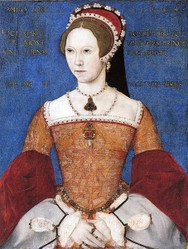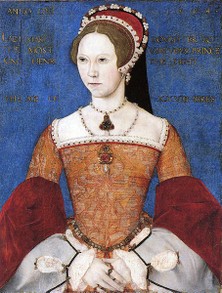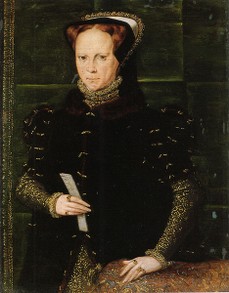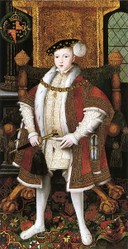Mary I was the first child of Henry VIII and the only living child of Catherine of Aragon. She gained the nickname “Bloody Mary” after persecuting 300 protestants in an attempt to turn England back into a catholic country. It is important to consider her childhood to understand her mentality during this period and how she turned from a respected to a feared Queen. While she was not physically abused by her parents, the actions of her father may have mentally abused her.

Mary I: How Henry VIII's Actions Turned Her into Bloody Mary
Mary I is known as Bloody Mary after burning 300 protestants at the stake. It is interesting to look how Henry VIII's actions may have led to Mary's end.
Princess Mary: The Beloved Daughter of Henry VIII
When Mary was born, her father was not instantly disappointed. While Henry VIII needed an heir, he and Catherine of Aragon were still young; there was still more chance that Catherine would have more children and that they would be boys. She was the first successful birth for the royal couple, which was a celebration in itself considering the medical care in Tudor England.
Henry VIII organised a number of marriage for his daughter, between Spain and France, but none were ever successful for various reasons. She was a pawn for Henry’s political power but treaties between the two countries and England never lasted long enough.
It was not Mary’s fault that she fell out of favour with Henry VIII. By 1526, Catherine of Aragon had failed to provide the King with the heir that he needed and was unable to have more children. Henry VIII had started to have doubts that his marriage to her was valid in the eyes of God and wanted a divorce. Around this time, he had also fallen for Anne Boleyn.
Catherine was certain that her marriage was valid. While she had married Henry’s brother, Arthur, that marriage had only lasted six months and had never been consummated before Arthur’s death in 1501. A papal dispensation had been granted to Henry VII so his second son could marry the Spanish princess. She fought the divorce every step of the way and part of the punishment for that was never being able to speak or write to her daughter. Mary took this hard as she was very close to her mother.
What If: How Would Mary I’s Life Changed Had Events Happened Differently
It is worth looking at two scenarios to see how Mary I’s life could have been different. The first is to consider the way Henry VIII treat Anne of Cleves. In 1540, Anne of Cleves married Henry VIII but just six months later their marriage was annulled. Anne never fought against Henry for this and agreed to his terms of remaining in England and living as “the King’s good sister”. She became one of the wealthiest women at the time on a yearly wage of £4,000.
Had Catherine simply agreed to her divorce, it is likely that she and Mary would have lived their lives happily. Henry wanted Catherine to live the rest of her years in a nunnery and she would have been looked after. Henry was a trustworthy man and it can be presumed that he would have stuck to his word had Catherine just co-operated. Of course, the question is why should she if she was so certain that she was in the right?
Another scenario is if the religious reformation had happened under different circumstances. Had it never happened, it would have been considered normal for protestants to be burned at the stake; this was considered heresy at the time. The name “Bloody Mary” came because she persecuted people following the religion they have been allowed to follow for decades before. While the persecutions could have happened no matter how the religious reformation occurred, it is unlike Mary would have been so forceful with the return to the catholic church had they happened for a different reason.
Henry VIII used a change in religion to get his own way. He wanted the divorce and to marry Anne Boleyn and this was the best way to get that. In a short space of time, Mary went from being a princess to an illegitimate heir. It is possible that Henry would have allowed Mary to remain in the line of succession had Catherine agreed to the divorce and the reformation happened gradually over time. It is possible that Mary held onto the catholic religion because it was all she had left of her mother. She was furious with her father for taking Catherine away from her and fought back every step of the way; leading to the persecutions of 300 people – many of whom were part of the original changes, such as Thomas Cranmer.
Mary I Lives Under the Rule of Anne Boleyn
It is no secret that Mary never liked her step-mother, Anne Boleyn. In Mary’s eyes, along with the eyes of many of the English people, Anne was a home-wrecker and had no right to take the crown away from Catherine of Aragon. Anne knew that Mary I was a threat; the English people loved Catherine and Mary and despised her.
Mary feared for her life while living under the rule of Anne Boleyn; believing that she wanted her and her mother dead. This would have been at the start of Mary’s teenage years, when she would have been most influential. On top of that, the ability to no longer see her mother or know how she was doing would have been heartbreaking for her.
Books About Mary I
 | The Myth of "Bloody Mary": A Biography of Queen Mary I of England It is the tragedy of Queen Mary that today, 450 years after her death, she remains the most hated, least understood monarch in English history—remembered best for burning hundre... |
 | Mary, Bloody Mary The story of Mary Tudor's childhood is a classic fairy tale: A princess who is toinherit the throne of England is separated from her mother; abused by an evilstepmother who has ... |
 | Bloody Mary Here is the tragic, stormy life of Mary Tudor, daughter of Henry VIII and Katherine of Aragon. Her story is a chronicle of courage and faith, betrayal and treachery-set amidst t... |
 | Mary Tudor: Courageous Queen or Bloody Mary? (Wicked History) Book Details:Format: PaperbackPublication Date: 9/1/2008Pages: 128Reading Level: Age 12 and Up |
The Birth of Elizabeth I
If being left out of the line of succession was not bad enough for Mary, the birth of her half-sister, Elizabeth, made it worse. Mary was made a lady-in-waiting to the infant princess but was not allowed to be in the sight of her father or Anne whenever they would visit. Not only was Mary banned from seeing her mother, she was not allowed to see her father either. This emotional abuse would have left a lasting impression and it was no wonder she resented the religious reformation and the protestants of England.
Mary was ill on a regular basis. While being ill regularly was a sign of the times, this could be part of her ill-treatment. She was treated worse than the other ladies-in-waiting to Elizabeth and constantly worried about an attempt on her life. She was worried about her mother and was banned from Catherine’s funeral in January 1536.
However, while she had reasons to be jealous of Elizabeth, after the fall of Anne Boleyn, they had much in common. It seems that Mary cared for her sister and tried to protect her. The only time Mary ever placed restrictions on her step-sister were when there were rebel uprisings in the name of Elizabeth. Mary had every reason to believe her half-sister was after the throne at the time.
Further Conditions for Mary Tudor
After the fall of Anne Boleyn, Henry VIII married again. His third wife was a meek woman named Jane Seymour, who was raised in the catholic religion. Jane did everything she could to bring Mary and Henry back together. However, Henry VIII imposed conditions for a relationship with his own daughter. Mary had to acknowledge that Henry was the head of the church and that there was no papal authority. She had to acknowledge that she was an illegitimate child and that the marriage between himself and her mother was never valid.
These conditions would have made Mary feel inadequate and that her father didn’t really want his daughter back into his life. It would have felt that Henry simply needed Mary to prove that she view him in the way he wanted, which would have helped convince the rest of England to view him in that way. At this point, there were still many of the English people against the reformation.
In the end, Mary decided that signing the documents was right to get her father back into her life. It is likely that she was bullied into signing. She found herself back at court but practised her own religion behind closed doors. She remained true to her mother’s faith.
It was not until 1543 that Mary was placed back into the line of succession, after Henry’s marriage to Katherine Parr. She remained illegitimate and was placed after her half-brother, Edward, the son of Jane Seymour.
Edward VI’s Belittles Mary I
After Henry VIII’s death, Mary’s battles against the religious reformation were not over. Her brother, Edward, became King of England. He had been raised as a protestant and wanted to take the reformation further. He knew that Mary was still a devout catholic and this was often a cause for conflict between the two. Edward VI often threatened Mary that he would have her arrested as a heretic and belittled her in public because of her believes; reducing her to tears on at least one occasion.
Edward attempted to stop Mary from succeeding the throne so that Lady Jane Grey would gain that right. He wanted to stop all women from succeeding the throne, since he believed that they were weak; just like his father. Jane Grey was the only English relative that had a strong claim to the throne at the time, so a woman it had to be.
Mary I Becomes Queen of England
Mary heard about her brother’s death and after just nine days of being on the throne, Lady Jane Grey saw her crown taken from her. The people were still in favour of Mary, including the protestants. This should have been a sign that she was accepted and should have let the country remain as it was. However, upon taking control of the throne and placing Lady Jane Grey and her family in the Tower, Mary took the steps to turn the country back into the one it was before Henry VIII divorced Catherine of Aragon.
Historians believe that the psychological abuse would not have been all that affect Mary. It was likely that she suffered from a problem with her ovaries since she could not have children. Doctors believe that she had ovarian cancer, which is why she only lived to the age of 42. For whatever reason, Mary could not have any children.
In fact, Mary suffered two phantom pregnancies after marrying Philip of Spain. While the second was close to her death, the first was early into her reign and would have affected her mindset. She would have been distraught believing that she was pregnant for nine months and realising that there was no heir to her throne.
It is likely that Mary’s outbursts by burning 300 protestants was a way of fighting back after years of emotional abuse. She was one loved by her father but he made her sign an oath to state that his marriage to her mother was never valid. He broke away from the catholic church just to gain the divorce he wanted so that he could marry Anne Boleyn. Henry VIII forced Mary to view him as the head of the church and her brother belittled and threatened her when she just wanted to practise the religion of her mother; the only thing that she had left. While Mary’s actions can never be excused, it is interesting to look at them from her possible point of view.
You might also like
England Under the Tudors: Would King Edward VI Have Been a Goo...Edward VI reigned between 1547 and 1553 when he was just a boy. It's hard to ...
Lady Jane Boleyn: Vindictive Woman or Pawn in a Plot?Jane Boleyn is known for her part in bringing down the Boleyn faction. How mu...





 Alternate History: What If Mary I Had a Child?on 01/26/2015
Alternate History: What If Mary I Had a Child?on 01/26/2015
 Francis II of France Dies: Mary, Queen of Scots Returns Homeon 12/05/2014
Francis II of France Dies: Mary, Queen of Scots Returns Homeon 12/05/2014
 Does Writedge Pay? Payment Proofon 12/03/2014
Does Writedge Pay? Payment Proofon 12/03/2014
 Alternate History: What If Lady Jane Grey Was Not Deposed?on 11/11/2014
Alternate History: What If Lady Jane Grey Was Not Deposed?on 11/11/2014



Comments
Thanks, WiseFool - I'm sorry it's taken me so long to reply! I've always been interested in Mary I and why she would feel like burning 300 protestants at the stake was justifiable. During history lessons, she was always made out to be the bad Queen while Elizabeth I was always viewed as the great one. There must have been a reason for Mary's actions and I've always thought Henry VIII had everything to do with that.
Really interesting piece, Aingham. Jo's quite right, when you look at the bare facts of Mary's life, it is easy to see why she was troubled and so single-minded about returning the country to Catholicism. She must have seen it as justice - although, clearly, dished out to the wrong people.
You're right, Jo. It is surprising she survived as well as she did. When learning history at school, they concentrated so much on the fact that she wanted the country to go back to the Catholic ways and I always wanted to know why. I don't think she was a bad person deep down. She had gone through such a terrible childhood and was forced into so much that it was bound to have negative influences later in life.
When it's all laid out like this, there's hardly any wonder that Mary was a little disturbed. That she survived as sanely as she did is the biggest miracle of all. I think that I'd have gone under.